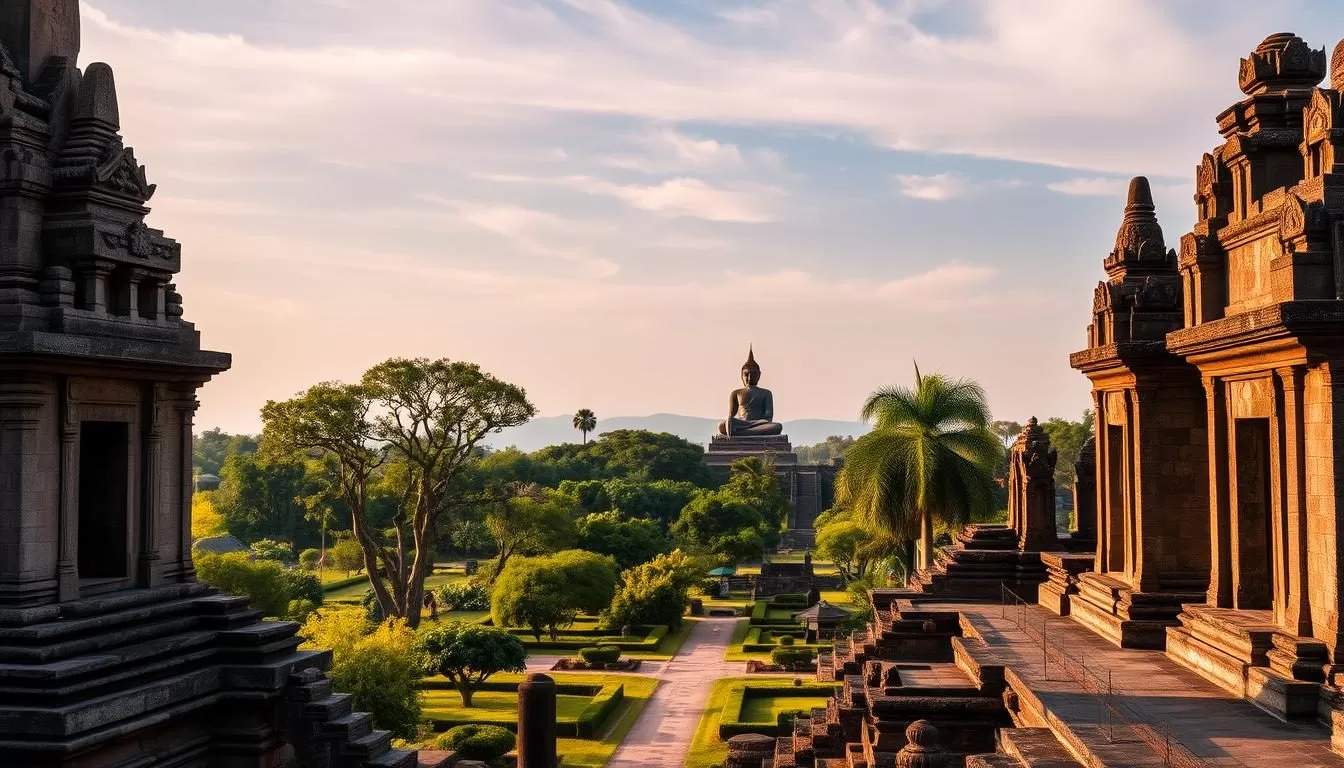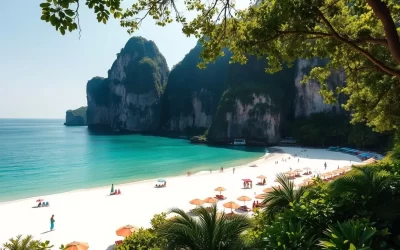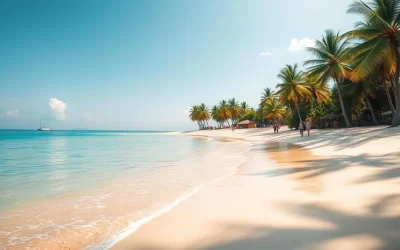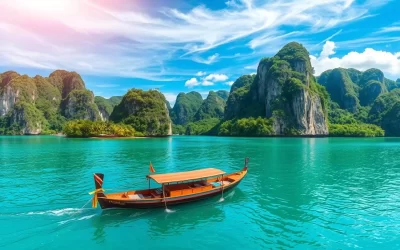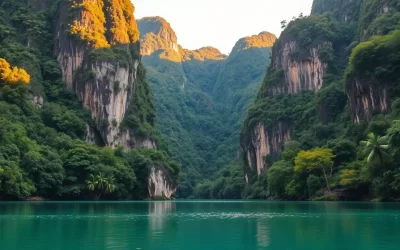Imagine stepping into a city that was once the cradle of Thai civilization, where the roots of the country’s rich culture and history run deep. You are now in Sukhothai, a seemingly small town in the lower northern part of Thailand that was once home to the first capital city of Siam in the 13th Century.
Founded by the great King Ramkhamhaeng, Sukhothai is considered the birthplace of all things traditional Thai, from art to architectural styles seen across the country. As you explore this historical city, you’ll discover the significance of the temples and ruins within the historical park, a UNESCO World Heritage Site.
Your journey through Sukhothai will be a comprehensive guide to understanding the city’s influence on Thai culture today, making it an essential travel guide for anyone looking to delve into the heart of Thailand’s history.
Discovering the Ancient Capital of Siam
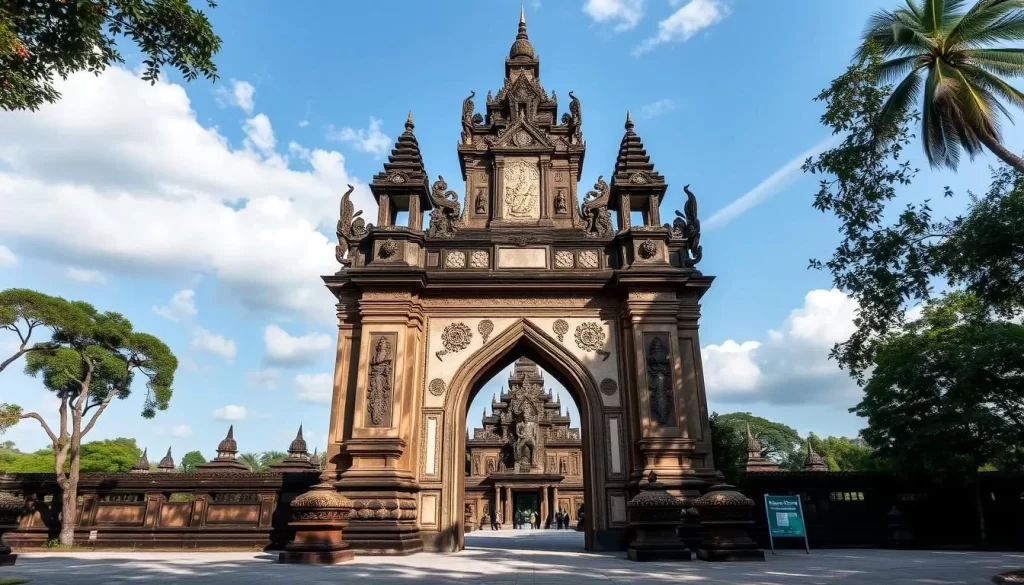
As you step into Sukhothai, you’re walking into a city that dates back to the 13th century, rich in historical significance. This ancient city, much like Ayutthaya, has been meticulously restored, allowing visitors to explore the ruins scattered throughout the Sukhothai Historical Park.
Sukhothai was once Thailand’s first independent kingdom capital, marking the beginning of a new era in the country’s history. The Sukhothai period, translating to “Dawn of Happiness,” is revered as the golden age in Thailand’s history. It was during this era that King Ramkhamhaeng introduced the Thai alphabet, laying the groundwork for significant artistic and intellectual advancements.
- Step back in time to the 13th century when Sukhothai served as the first independent kingdom of Siam, establishing the foundations of modern Thailand.
- Understand why historians refer to the Sukhothai period as the “Dawn of Happiness” and Thailand’s golden age of cultural and artistic development.
- Learn about King Ramkhamhaeng’s crucial contributions, including the creation of the Thai alphabet and expansion of the kingdom’s influence.
- Discover how Sukhothai’s architectural style, art forms, and cultural practices set standards that would influence Thai society for centuries to come.
- Appreciate the historical significance of this ancient city as you prepare to explore its well-preserved ruins and understand its place in Thailand’s rich heritage.
By exploring Sukhothai, you are not just visiting a place; you are experiencing the essence of Thailand’s history and culture. The city’s influence on the country’s development is undeniable, making it a must-visit destination for anyone interested in Sukhothai historical significance.
Sukhothai Historical Park: A UNESCO World Heritage Site
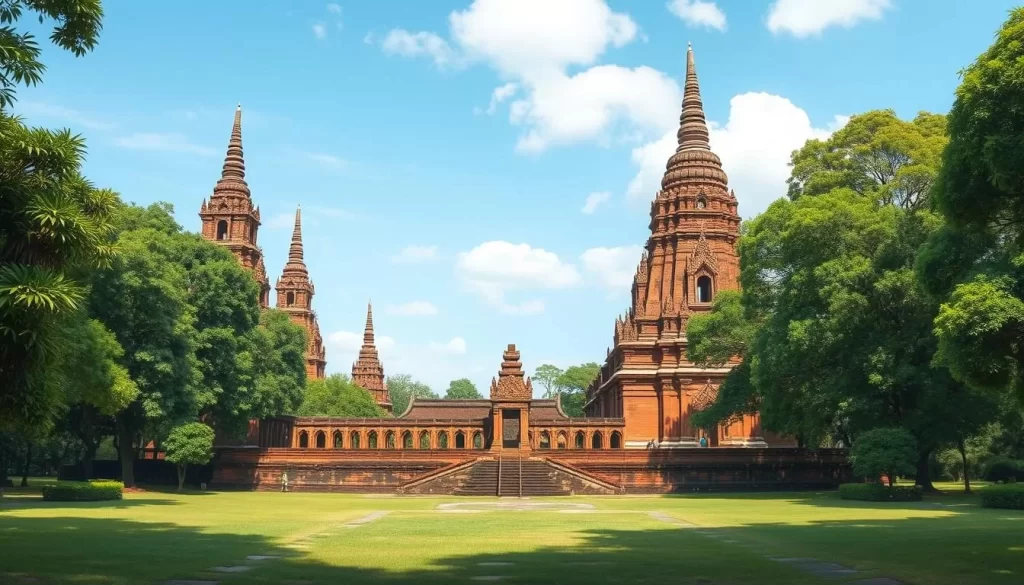
Step into the ancient world of Sukhothai Historical Park, a UNESCO-recognized treasure trove of Thai culture. This UNESCO World Heritage site stands as a testament to Thailand’s storied and colorful past, and it should be your first place to visit on a trip to Sukhothai.
Nearly 200 temples were excavated and partly reconstructed here, providing visitors with a unique look at what Thailand’s early capital might have been like. In the city’s heyday, three earthen walls and two moats surrounded the old center. Twenty-one wats and four ponds were uncovered during excavations, giving insight into the historical significance of the park’s layout.
The Sukhothai Historical Park is expansive, covering an area of approximately 70 square kilometers. To navigate this vast area efficiently, renting a bike is highly recommended. It’s the most popular and enjoyable way to explore the scattered ruins and temples.
- Explore the expansive Sukhothai Historical Park, a UNESCO World Heritage Site that preserves the remnants of Thailand’s first capital city.
- Discover the park’s layout with its three distinct zones (central, northern, and western), each requiring separate entrance fees but offering unique temple ruins and historical structures.
- Learn how to navigate the 70-square-kilometer area efficiently by renting a bike, which is the most popular and enjoyable way to explore the scattered temples and ruins.
- Understand the historical significance of the site’s layout, with its original three earthen walls, two moats, and strategic placement of temples and ponds.
- Appreciate the meticulous restoration work that has brought nearly 200 temples and structures back to life, giving visitors a glimpse into Thailand’s golden age.
By exploring Sukhothai Historical Park, you are not only witnessing the remnants of a bygone era but also experiencing the cradle of Thai culture. Archaeologists have found remnants of artistic and religious works that defined a society for centuries, making this site a truly enriching experience.
Wat Mahathat: The Crown Jewel of Sukhothai
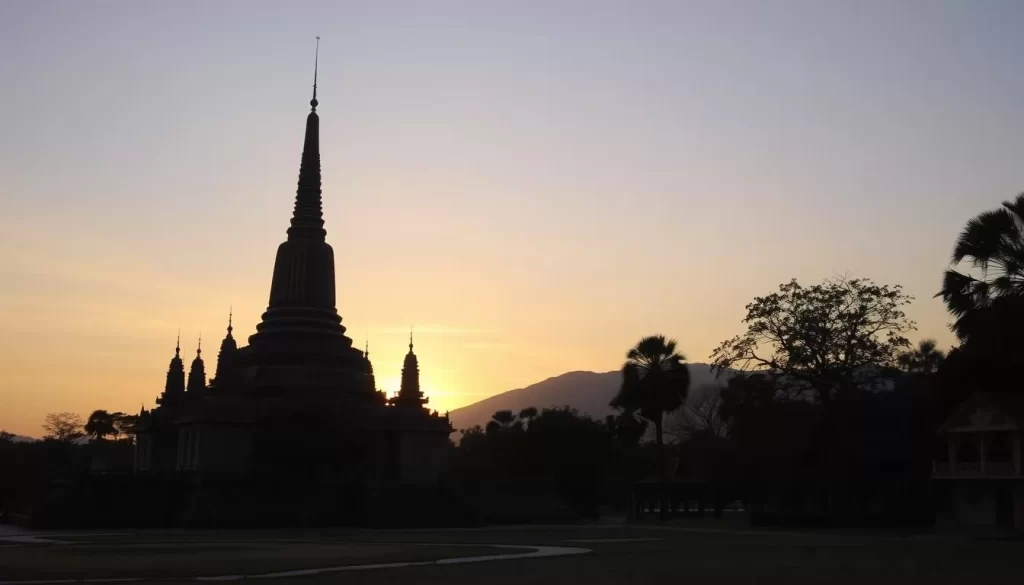
Wat Mahathat stands as the most magnificent temple in Sukhothai, embodying the spiritual essence of the ancient kingdom. Originally located next to the ancient Royal Palace, the temple complex once sprawled over four hectares, featuring 185 chedis, six wiharn of varying sizes, a bot, and eleven salas.
As you explore Wat Mahathat, you’ll be struck by the towering main chedi, exemplifying the pure Sukhothai architectural style with its distinctive lotus bud crown. This historical site is not just a testament to the religious significance of Sukhothai but also a reflection of its political importance, given its proximity to the former Royal Palace.
The Wat Mahathat complex, part of the Sukhothai Historical Park, a UNESCO World Heritage Site, offers visitors a glimpse into the 13th-century Sukhothai era. You can marvel at the remaining structures, including the wiharn and bot, and imagine the religious practices that once took place here, centered around the teachings of Buddha.
To make the most of your visit, consider arriving early in the morning to capture stunning photographs of Wat Mahathat against the rising sun, avoiding the crowds and heat of the day. This strategic timing not only enhances your photographic experience but also allows for a more serene and contemplative visit to this sacred site, which dates back to the 14th century.
As you wander through the temple grounds, take a moment to appreciate the historical context and architectural nuances that make Wat Phra Mahathat a standout destination in Sukhothai.
Wat Si Chum: Home to the Impressive Phra Achana Buddha
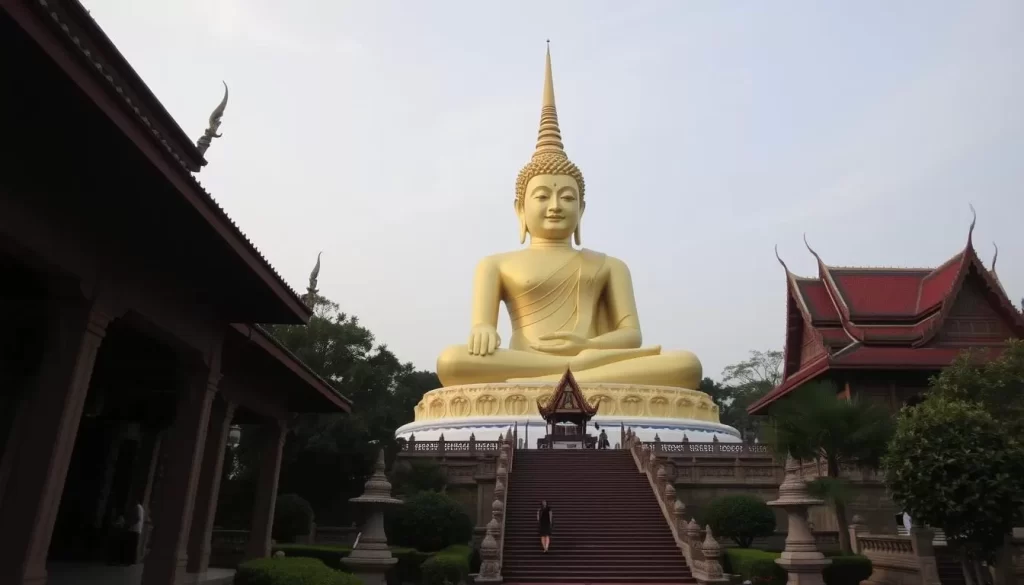
As you explore the ancient city of Sukhothai, you’ll encounter the magnificent Wat Si Chum, a temple renowned for its colossal Buddha image. This 14th-century marvel is easily recognizable due to its 15-meter-tall seated Buddha, which leans against a brick wall in the open, exuding an aura of serenity.
The Wat Si Chum complex is centered around the mondhop, a massive, windowless cuboid construction standing on a high pedestal. This unique structure houses the enormous Buddha statue, creating an awe-inspiring experience for visitors. The mondhop is not just an architectural feat but also a testament to the craftsmanship of the era.
A notable feature of Wat Si Chum is the narrow, enclosed staircase on one of its southern walls. This staircase leads to the roof, offering beautiful, panoramic views of the historical park. Historically, the stair passage was adorned with engraved slates featuring various images of Buddha, providing valuable insights into the artistic styles of the time.
Visitors can also explore the surrounding area, which includes the ruins of another temple and a brick building containing a seated Buddha. The legend of the “Speaking Buddha” adds a fascinating layer to the site’s history, where King Naresuan allegedly used the temple’s acoustics to inspire his troops.
Standing before the massive Phra Achana Buddha, you’ll be struck by the serene expression on its face. The name “Achana,” meaning “one who is not frightened,” aptly captures the essence of this magnificent statue. Wat Si Chum is a highlight of Sukhothai’s Historical Park, offering a glimpse into the region’s rich cultural and religious heritage.
Exploring the North Zone: Wat Phra Pai Luang and Beyond
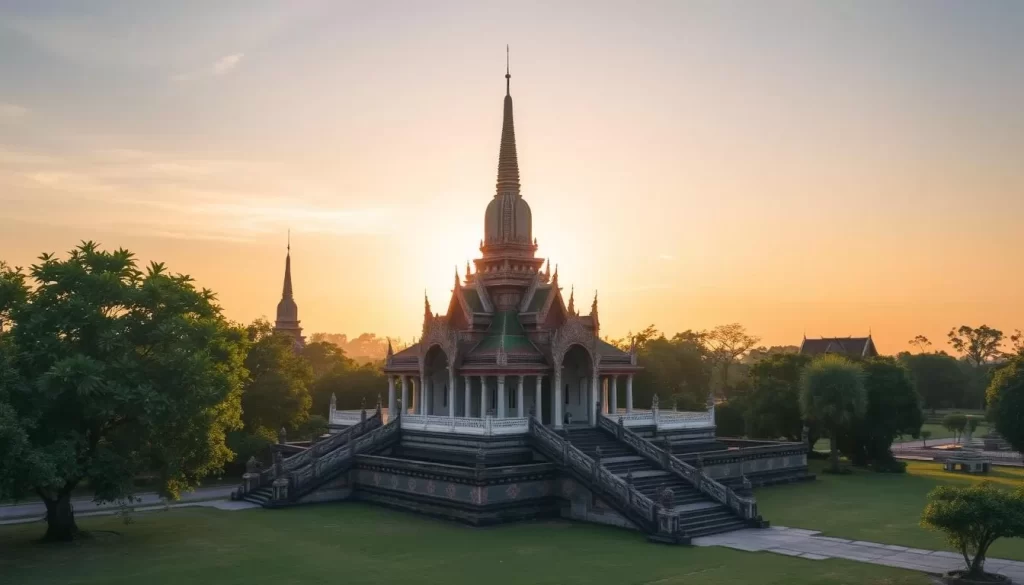
Beyond the central zone, the northern section of Sukhothai Historical Park awaits your exploration. This area is home to some of the most historically significant temples, including Wat Phra Pai Luang, one of the oldest temples in the Sukhothai area.
Wat Phra Pai Luang is thought to date back to the end of the 12th or beginning of the 13th century, predating the establishment of the Sukhothai Kingdom. This temple was once one of the most important wats in the region, showcasing a unique architectural blend with Khmer influences from the Angkor period visible in its remaining prang (tower).
The temple is adorned with beautiful stucco work on the chedi steps and walls, demonstrating the artistic sophistication of early Sukhothai craftsmen. You can still see the foundations and ruins of four rows of columns that remained from the wiharn, giving you a glimpse into the temple’s past grandeur.
Visiting Wat Phra Pai Luang offers a more serene experience compared to the more popular temples in the central zone. You can enjoy the quiet sunset falling over the ruins, making it a perfect visit for later in the day.
Some highlights of exploring the North Zone include:
– Venturing beyond the central zone to discover the less-visited but historically significant northern section of Sukhothai Historical Park.
– Exploring Wat Phra Pai Luang, one of the oldest temples in the area, dating back to the late 12th century.
– Observing the unique architectural blend at Wat Phra Pai Luang, showcasing Khmer influences.
– Appreciating the beautiful stucco work that adorns the chedi steps and walls.
– Enjoying the quieter atmosphere of the northern zone, with fewer tourists.
The West Zone Treasures: Wat Saphan Hin and Scenic Views
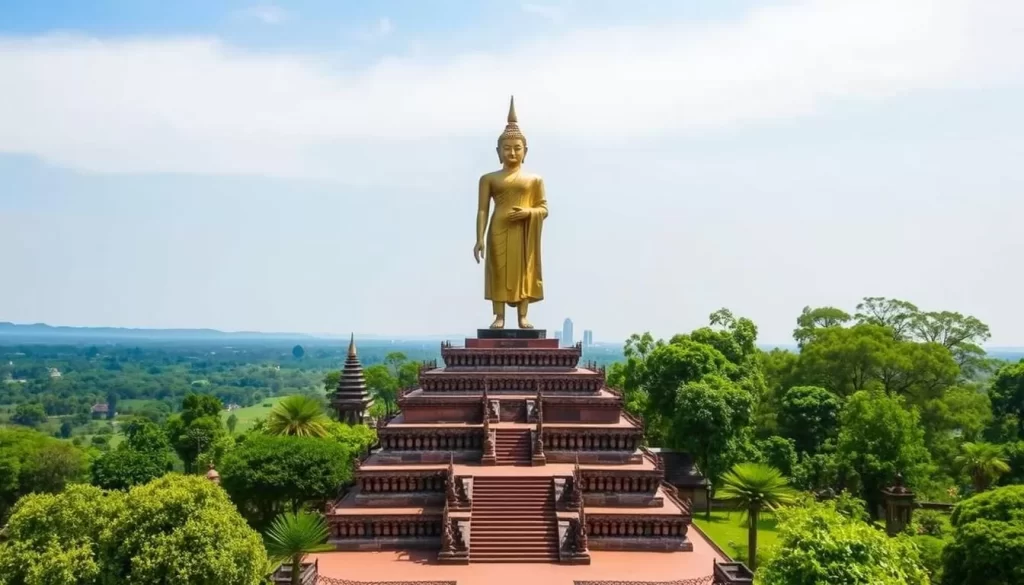
As you venture into the western zone of Sukhothai Historical Park, you’ll discover the majestic Wat Saphan Hin, perched atop a hill. This magnificent temple, also known as the “Temple of the Stone Bridge,” is a must-visit attraction due to its historical significance and breathtaking views.
The temple’s name refers to the ancient slate pathway that leads up to the hilltop sanctuary. The climb is rewarding, as you’ll be greeted by panoramic views of the entire park and surrounding temples. At the heart of the temple lies an impressive 12.5-meter-high statue of a standing Buddha, leaning against a brick wall in the open. Visitors often leave flowers at its feet as a sign of respect.
In addition to the main temple, the area is home to the ruins of another temple and a chedi, which historians believe might have been part of a single massive structure. The western zone, including Wat Chedi Ngarm hidden within a small forest area, offers a serene and peaceful exploration experience, far removed from the crowds in the central park.
Some highlights of your visit include:
- Hiking up to Wat Saphan Hin, situated 200 meters high on a hill in the western zone, offering stunning views of the historical park.
- Learning about the temple’s history and significance.
- Discovering other less-visited temples in the western zone.
- Appreciating the tranquility of the western zone.
Visiting Wat Saphan Hin is an unforgettable experience, with its rich history, architectural marvels, and scenic views. As you explore this magnificent temple and its surroundings, you’ll gain a deeper appreciation for the cultural heritage of Sukhothai Historical Park.
Sukhothai, Thailand: Best Things to Do Outside the Historical Park
Venture beyond Sukhothai Historical Park to uncover the region’s hidden gems and cultural treasures. While the historical park is a must-visit, the surrounding area offers a wealth of enriching experiences that provide a more comprehensive understanding of Sukhothai’s history and cultural significance.
Ramkhamhaeng National Museum
The Ramkhamhaeng National Museum is a treasure trove of Sukhothai’s history, housing artifacts excavated from both Sukhothai Historical Park and Si Satchanalai Historical Park. You can explore the development of the Sukhothai style, from the era of Khmer influence to the rise of the Ayutthaya style, through the museum’s impressive collection of Buddha images, ceramics, and the famous Ramkhamhaeng inscription.
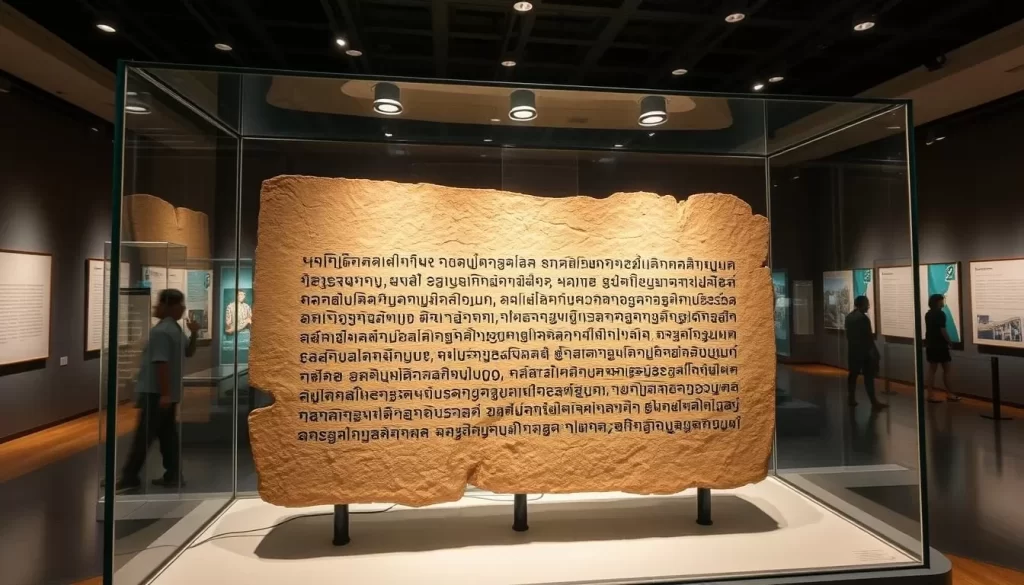
Si Satchanalai Historical Park Day Trip
Take a day trip to Si Satchanalai Historical Park, located about 55 kilometers north of Sukhothai. This park is home to numerous temples and ruins, including Wat Phra Si Rattana Mahathat, with its impressive corn-cob shaped prang and beautiful laterite walls. You can also visit the Celadon Kiln Site and Study Center to learn about ancient ceramic production and see excavated kilns and pottery from Sukhothai’s thriving ceramic industry.
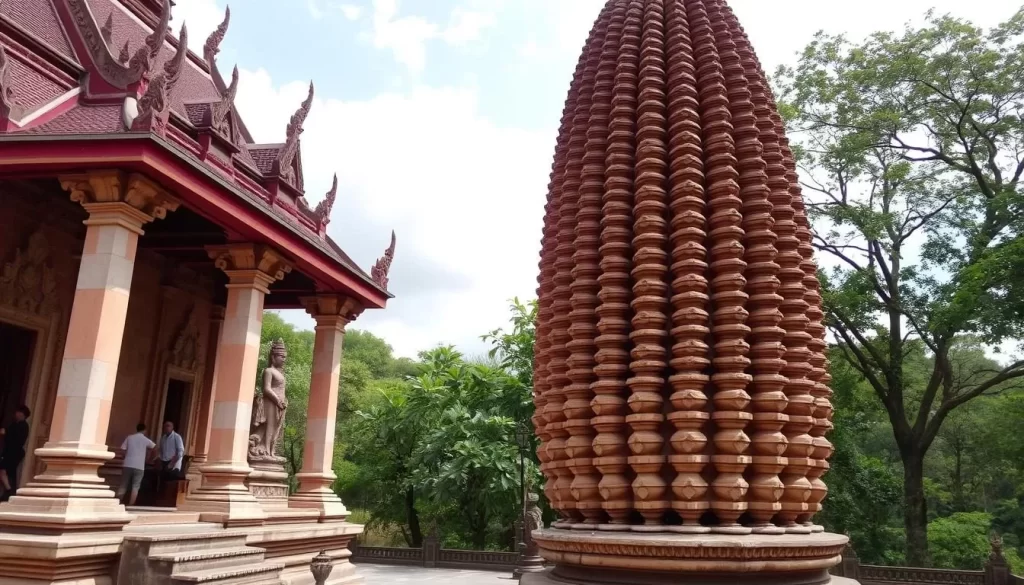
By exploring these attractions, you can expand your Sukhothai experience beyond the main sukhothai historical park and gain a deeper understanding of the region’s rich history and cultural heritage.
Local Experiences: Cycling Tours and Thai Cuisine
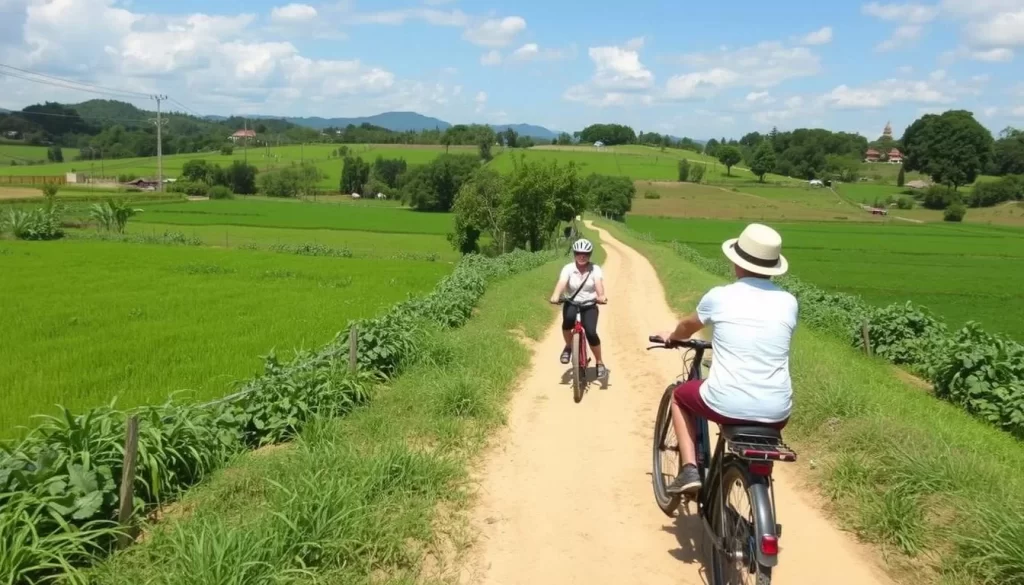
Beyond the ancient ruins, Sukhothai’s true essence is revealed through its local experiences, including bike tours and traditional Thai cuisine. One of the highlights is a guided cycling tour that takes you through the picturesque countryside, local villages, and rice fields, offering a glimpse into rural Thai life.
Some of the top activities to enjoy in Sukhothai include:
- Immerse yourself in local Sukhothai life through guided cycling tours that take you beyond the historical sites into surrounding villages and rice fields.
- Sample authentic Sukhothai noodles (kuay tiaw Sukhothai), the region’s signature dish featuring rice noodles in a flavorful broth with sliced pork, green beans, and ground peanuts.
- Join a local cooking class to learn how to prepare traditional central Thai dishes using fresh ingredients from nearby markets.
- Experience the relaxed pace of life in Old Sukhothai town, with its charming streets, local markets, and friendly residents.
- Visit Wat Traphang Thong market in the evening to mingle with locals and sample a variety of street foods and snacks in an authentic setting.
By engaging in these activities, you’ll gain a deeper understanding of Sukhothai’s culture and daily life, making your visit even more memorable.
Best Time to Visit Sukhothai

Understanding Sukhothai’s climate is key to enjoying a comfortable and enriching travel experience. The best time to visit Sukhothai is during the cool season, from November to February, when temperatures are pleasant, ranging from 68°F to 86°F (20°C to 30°C), and rainfall is minimal.
Consider planning your time visit during the Loy Krathong festival, usually in November, when Sukhothai hosts one of Thailand’s most beautiful celebrations. The historical park’s waterways are illuminated by floating lanterns, creating a breathtakingly beautiful scene.
Avoid the hot season from March to May, as temperatures can soar above 100°F (38°C), making exploration of the temples uncomfortable, especially during midday hours.
If you are planning to visit during the rainy season (June to October), plan your activities for the morning and be prepared for afternoon showers. Although the rain might seem inconvenient, the lush green landscape that follows offers beautiful photography opportunities.
To fully appreciate Sukhothai’s historical significance and explore its various zones without rushing, schedule at least 2-3 full days in Sukhothai. This will allow you to enjoy the time to explore the historical park and nearby attractions.
Checking the weather forecast before your trip can also help you prepare accordingly. With the right time visit, your experience in Sukhothai will be even more memorable.
How to Get to Sukhothai and Getting Around
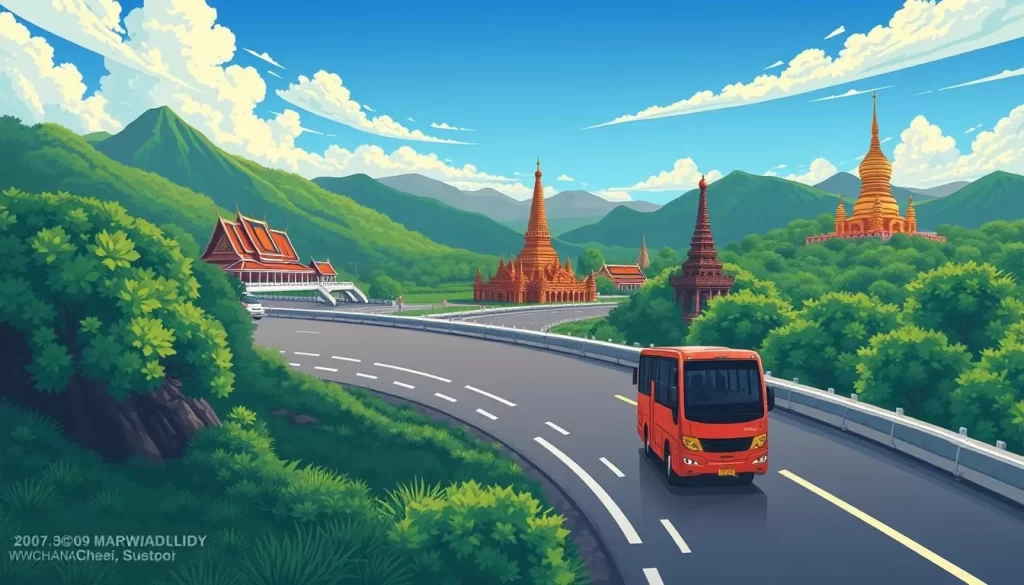
Getting to Sukhothai is easier than you think, with multiple transportation options available. You can travel to Sukhothai by air, bus, or train, depending on your starting location and preferred mode of transport.
If you’re flying, you can reach Sukhothai through the small Sukhothai Airport, which is serviced by Bangkok Airways with daily flights from Bangkok. The flight takes about 1 hour and 20 minutes. Alternatively, you can get to Sukhothai by bus from major cities like Chiang Mai, Bangkok, or Ayutthaya.
Traveling by bus from Chiang Mai to Sukhothai takes around 5-6 hours, with prices starting from approximately $9 USD per person one way. The bus journey includes three stops, allowing you to stretch your legs. It’s recommended to book your tickets in advance as the buses can get booked up. You can also consider taking the train to Phitsanulok and then a 1-hour bus connection to Sukhothai if you prefer rail travel.
Once you arrive in Sukhothai, you can navigate between New Sukhothai (where most transportation arrives) and Old Sukhothai (the historical area) via frequent songthaews (shared pickup trucks) that cost around 30 baht per person. To explore the historical park and surrounding areas at your own pace, you can rent a bicycle in Old Sukhothai for around 50 baht per day.
The road to Sukhothai is scenic, and the journey is quite lovely. Whether you’re coming from Chiang Mai or Bangkok, the travel time varies, but the destination is well worth it. You can expect to spend around 7-8 hours on the road if you’re coming from Bangkok, while the journey from Ayutthaya takes around 6 hours.
Overall, getting to Sukhothai and getting around the town is relatively easy, with various transportation options available to suit your needs.
Where to Stay in Sukhothai: Accommodation Options
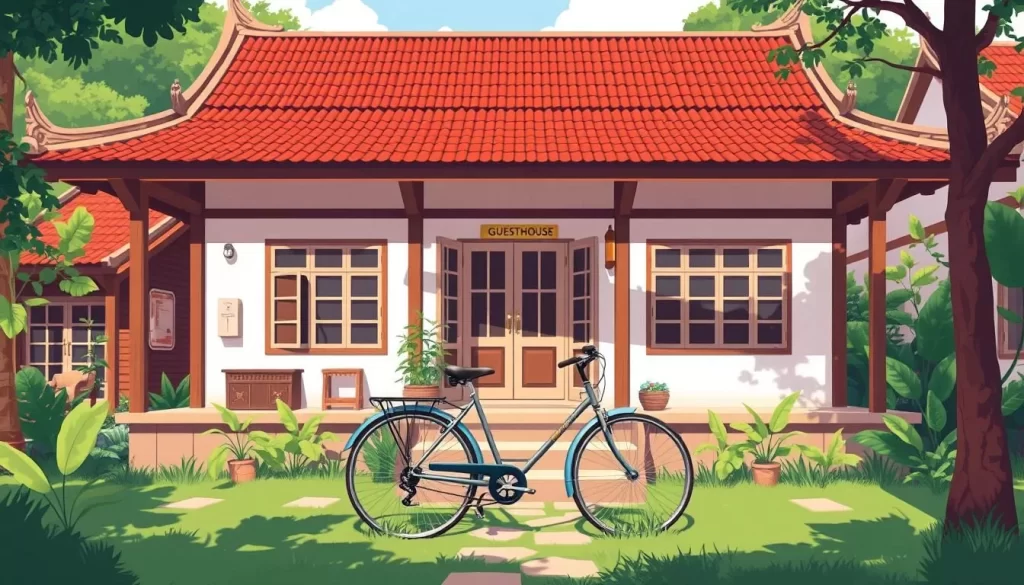
The ancient city of Sukhothai has a variety of accommodation options, catering to different preferences and budgets. When deciding where to stay, you have the option to choose between New Sukhothai, the modern town with more amenities, or Old Sukhothai, which is closer to the historical park.
For budget-friendly options, consider Smilingface Guesthouse, which offers a tent with a futon starting at around $14 USD per night with breakfast included. This is an excellent choice for travelers looking to save money without compromising on the experience.
For a more comfortable stay, mid-range accommodations like Thai Thai Sukhothai Resort or OldTown Boutique House are great choices. They offer comfortable rooms with pools and excellent breakfasts for approximately $30-40 USD per night.
If you’re looking to splurge, luxury resorts such as Sukhothai Treasure Resort & Spa or Tharaburi Resort offer elegant rooms, spa services, and premium amenities starting from $67 USD per night. These resorts provide a high-end experience, making your stay in Sukhothai truly memorable.
Regardless of your budget, it’s advisable to look for accommodations that offer bicycle rentals. Since the historical park is quite expansive, having a bicycle will be your primary mode of transportation for exploring the area and experiencing the beauty of the old city.
By choosing the right hotel or resort, you can enhance your overall experience in Sukhothai, making your visit to this historical place even more enjoyable.
Practical Tips for Your Sukhothai Visit
To make the most of your visit to Sukhothai, consider these practical tips. When planning your trip, it’s essential to understand the layout and requirements for exploring theSukhothai Historical Park.
You can purchase separate tickets for each zone of the historical park (100 baht each for foreigners) or consider a combined ticket if you plan to visit all areas. This flexibility allows you to tailor your visit according to your interests and time constraints.
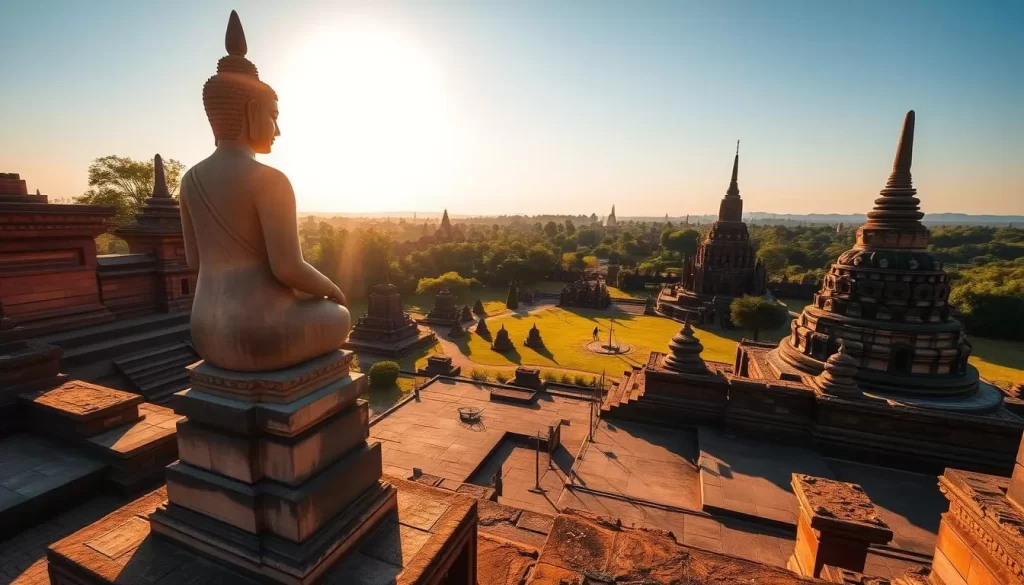
Starting your exploration early in the morning (around 6:30-7:00 AM) is advisable to avoid the midday heat and crowds, especially at popular temples like Wat Mahathat and Wat Si Chum. Additionally, applying insect repellent before visiting temples, particularly those near water features, will help protect against mosquitoes that can be abundant during dawn and dusk hours.
| Tips | Benefits |
|---|---|
| Dress respectfully | Showing respect for the temples and their surroundings |
| Carry sufficient water and sun protection | Staying hydrated and protected from the sun |
| Plan your route efficiently | Maximizing your time in the historical park |
For those interested in exploring beyond Sukhothai, a day trip to Si Satchanalai Historical Park is highly recommended. The journey takes approximately 1.5 hours one-way, and the bus ticket from Sukhothai Bus Terminal costs 49 THB. Upon arrival, you can rent a bike for 50 THB per day, which also includes the bus schedule back to Sukhothai. This allows you to travel at your own pace and enjoy the scenic views.
By following these practical tips, you can ensure a smooth and enjoyable trip to Sukhothai, making the most of your time and creating lasting memories.
Conclusion
Sukhothai, with its rich history and cultural significance, is undoubtedly a must-visit destination in Thailand. As the birthplace of Thai civilization, Sukhothai has played a pivotal role in shaping the cultural identity of modern Thailand. The Sukhothai Historical Park is a testament to this, boasting some of the most impressive temples in the country, including the magnificent Wat Mahathat and the impressive Buddha at Wat Si Chum.
One of the highlights of visiting Sukhothai is the opportunity to explore these historical sites without the crowds often found in other ancient cities like Ayutthaya. This allows for a more peaceful and authentic historical experience. To fully appreciate the city’s charm and historical significance, it’s recommended to spend at least 2-3 days here, taking the time to soak in the atmosphere and explore the surrounding areas.
As you plan your journey through Thailand, make sure to include Sukhothai in your itinerary. It’s an essential destination for understanding Thai history, architecture, and culture. With its unique blend of historical landmarks and cultural experiences, Sukhothai is sure to be a highlight of your trip. Whether you’re a history buff or simply looking to explore new and exciting places, Sukhothai has something to offer, making it a truly unforgettable experience.
